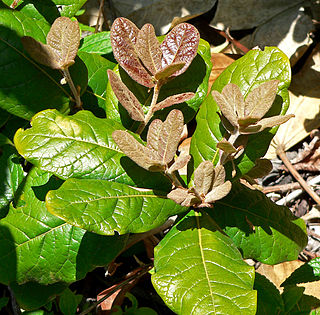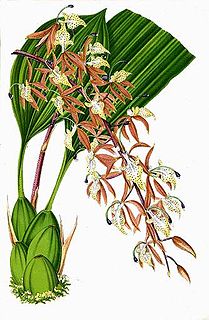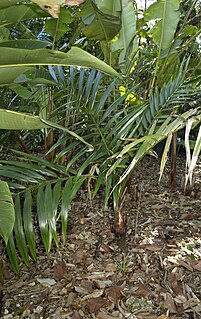The genus Cochleanthes is made up of 4 species of orchids native to Mexico, Central America, the West Indies and South America. The name Cochleanthes refers to the shape of the flower.
Dysopsis is a genus of plants in the family Euphorbiaceae, first described in 1858. It is the sole genus in subtribe Dysopsidinae. The genus is native to Costa Rica, Panama, South America, and the Juan Fernández Islands.
- Dysopsis glechomoides(A.Rich.) Müll.Arg. - Chile, S Argentina
- Dysopsis hirsuta(Müll.Arg.) Skottsb. - Juan Fernández Islands
- Dysopsis paucidentata(Müll.Arg.) Lozano & J.Murillo - Costa Rica, Panama, Colombia, Venezuela, Ecuador, Peru, Bolivia
Astrocasia is a plant genus of the family Phyllanthaceae first described as a genus in 1905. It is the sole genus in the subtribe Astrocasiinae. It is native to Mesoamerica, northern South America, and the western part of the West Indies.
- Astrocasia austinii(Standl.) G.L.Webster - Izabal
- Astrocasia diegoaeJ.Jiménez Ram. & Mart.Gord. - Guerrero
- Astrocasia jacobinensis(Müll.Arg.) G.L.Webster - Bahia, Bolivia
- Astrocasia neurocarpa(Müll.Arg.) I.M.Johnst. ex Standl. - Oaxaca, Querétaro, San Luis Potosí, Tamaulipas
- Astrocasia peltataStandl. - Costa Rica, Nayarit, Jalisco
- Astrocasia tremula (Griseb.) G.L.Webster - Mexico, Central America, West Indies, northern South America

Calyptrogyne is a genus in the palm family (Arecaceae). The distribution of this genus is Central America, Colombia, and southern Mexico, with 11 of the 17 known species endemic to Panama. Calyptrogyne ghiesbreghtiana is the most widespread and best studied species in this genus.

Quercus costaricensis is a species of oak native to Central America. It is often found with Quercus copeyensis in the upper montane forests, to 3100 meters elevation. The leaves are tough and leathery with a short petiole and toothed margin. Wind is the primary pollinator. Squirrels are their main seed predator but also their main disperser as they commonly lose their buried seeds.

Dicranopygium is a genus of plants belonging to the family Cyclanthaceae, first described as a genus in 1954. They are distributed in the Neotropic ecozone from southern Mexico to Peru.

Spathiphyllum montanum is a flowering plant of the genus Spathiphyllum in the family Araceae. It is native to Panama and Costa Rica.
Thoracocarpus is a genus of plants first described as a genus in 1958. It contains only one known species, Thoracocarpus bissectus a hemiepiphytic vine. It is native to Costa Rica, Panama, Cuba, Trinidad & Tobago, and South America.

Polycycnis, abbreviated in horticultural trade as Pcn, is a genus of orchid, comprising 17 species found in Central America, and northern South America.
- Polycycnis acutilobaSchltr. - Colombia
- Polycycnis annectansDressler - Ecuador
- Polycycnis auritaDressler - Ecuador, Colombia
- Polycycnis barbata(Lindl.) Rchb.f. - Colombia, Venezuela, Panama, Costa Rica, Honduras
- Polycycnis blancoiG.Gerlach - Costa Rica
- Polycycnis escobarianaG.Gerlach - Colombia
- Polycycnis gratiosaEndrés & Rchb.f. - Panama, Costa Rica
- Polycycnis grayiDodson - Ecuador
- Polycycnis lehmanniiRolfe - Colombia
- Polycycnis lepidaLinden & Rchb.f. - Ecuador, Colombia, Peru
- Polycycnis muscifera(Lindl. & Paxton) Rchb.f. - Colombia, Venezuela, Panama, Costa Rica, Bolivia, Peru, Ecuador
- Polycycnis pfisteriSenghas, Tagges & G.Gerlach - Colombia
- Polycycnis silvanaF.Barros - Bahia
- Polycycnis surinamensisC.Schweinf - Panama, Colombia, Venezuela, Ecuador, Suriname, Guyana
- Polycycnis tortuosaDressler - Panama
- Polycycnis trulliferaD.E.Benn. & Christenson - Peru
- Polycycnis villegasianaG.Gerlach - Colombia

Sievekingia is a genus of orchid, comprising 20 species found in Central and South America, from Nicaragua east to the Guianas and south to Bolivia.

Neonicholsonia is a monotypic genus of flowering plant in the palm family native to Central America. The genus and species names honor George Nicholson, a former curator of the Royal Botanic Gardens, Kew and his successor William Watson.

Warmingia is a genus of orchids belonging to the subfamily Epidendroideae within the Orchidaceae family. It has four species, native to South and Central America.

Coelia macrostachya is a species of orchid. It is native to Chiapas, Guatemala, Honduras, El Salvador, Panama, Guerrero, Oaxaca, Veracruz.

Aechmea dactylina is a species in the genus Aechmea. This species is native to Costa Rica, Nicaragua, Panama, Colombia and Ecuador.

Cischweinfia is a genus of flowering plants from the orchid family, Orchidaceae. It was named after Harvard orchidologist Charles Schweinfurth. It has eleven currently recognized species, all native to Central America and northwestern South America.
Warrea is a genus of flowering plants from the orchid family, Orchidaceae. It has three known species, all native to Latin America.
Pterichis is a genus of flowering plants from the orchid family, Orchidaceae. It is native to South America, Central America and Jamaica.
Solenocentrum is a genus of flowering plants from the orchid family, Orchidaceae. It is native to southeastern Central America and northwestern South America, from Costa Rica to Bolivia.
Systeloglossum is a genus of flowering plants from the orchid family, Orchidaceae. It contains 5 known species, all native to southeastern Central America and northwestern South America.
- Systeloglossum acuminatumAmes & C.Schweinf. - Costa Rica, Panama
- Systeloglossum bennettii(Garay) Dressler & N.H.Williams - Peru
- Systeloglossum costaricenseSchltr. - Peru
- Systeloglossum ecuadorense(Garay) Dressler & N.H.Williams - Ecuador
- Systeloglossum panamenseDressler & N.H.Williams - Panama

Brachystele guayanensis is a species of orchid. It is native to southern Mexico, Central America, Trinidad & Tobago, and northern South America.













